
March 28, 2022
When I moved from the mainland to Hawaii in 1983, I laughed at residents who didn’t swim or snorkel in winter because it was too cold. Now, I’m one of them. But in addition to big surf and cool temperatures keeping me out of the ocean this winter, I’ve been busy with a new undertaking. On January 17th, I became president of the Hawaii Audubon Society.
That honor has been keeping me busy as I learn the business of nonprofit organizations and help move this venerable Society, founded in 1939, forward. Check out the new website we launched this month, www.hiaudubon.org. We 10-member Board of Directors, two staff members, and dozens of volunteers, are all working for Hawaii’s birds and the habitats they need to survive and thrive.
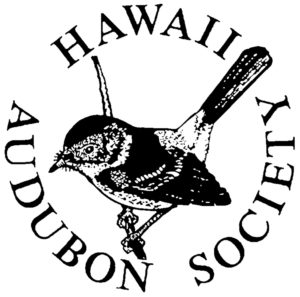
Fortunately, our native species didn’t care about the pandemic. Hawaii’s Kolea (Pacific Golden-Plovers), Manu o Kū (White Terns) and ‘Ua’u kani, (Wedge-tailed Shearwaters AKA wedgies) have been going about their business of continuing their species.
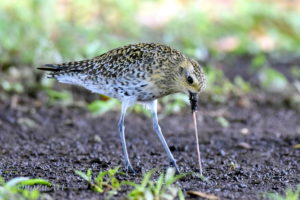
©Honolulu Kolea counter, Harumi Fujimoto, recently sent this outstanding photo of a Kolea catching one of its favorite foods, an earthworm.
This month Kolea fans and counters are enjoying watching our Kolea grow their spring breeding feathers. They’re also gaining weight. Some birds have plumped up so much the last couple weeks that Craig and I had to use binoculars to make sure we were seeing Kolea rather than spotted doves. Our plovers weigh about 4 ounces in winter, but bulk up to about 7 ounces by the end of April. The fat is essential fuel for their 3,000-mile nonstop journey to Alaska.
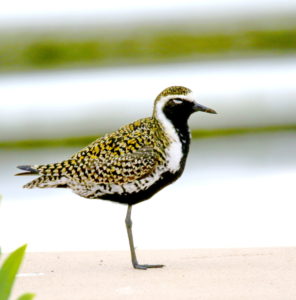
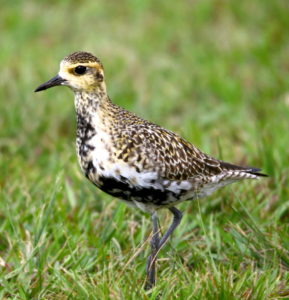
Males (left) have white feathers outlining the head and chest, and a solid black chest. (Kolea often rest standing on one leg. The other leg is fine.) Females (right) have mottled black, gold, and white feathers on their sides and chest. Both sexes have gold speckles throughout that get brighter in spring. ©Photos courtesy of Ann Tanimoto Johnson of the Big Island.
The 2021-2022 Kolea counting season (koleacount.org) will end March 31st because the birds start gathering in April as they get ready for their migration north. As of this writing, the Big Count has 280 entries with over 4,000 birds reported, and the Little Count has 146 entries. Citizens’ observations continue. Thank you for helping us monitor our amazing plovers. Please note, and record, the last day you saw your bird(s) as well as any that you see in June. By mid-to-end July, we’ll be seeing our first returnees, and that starts the 2022-2023 Kolea Count.
Our Manu o Ku (whiteterns.org/) are doing well too. White Tern researcher, Rich Downs (Hawaii Audubon’s new VP) recently trained Kupu intern, Sherine Boomla, hired by the DLNR, to help monitor the terns breeding in Honolulu.
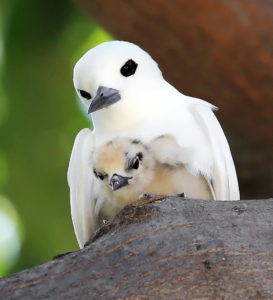
The current White Tern population estimate in Honolulu is approximately 3,000. In 1961, we had three (one adult pair raised one chick.) ©Photo courtesy of Melody Bentz, Hui Manu o Kū member.
These seabirds love our city’s manicured trees, nesting (so far) only between Hawaii Kai and Pearl Harbor on Oahu and nowhere else on the main Islands. The blue ribbons around tree trunks, placed by Rich, Sherine, and Manu o Kū volunteers, tell the city’s arborists (and we admirers) that eggs or chicks are in that tree. The results of this effort have been promising, with tree trimming companies calling the White Tern hotline printed on the ribbons for pruning advice.
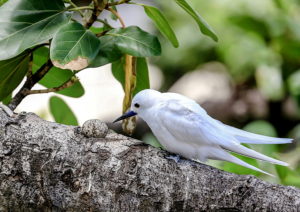
©Melody Bentz photo.
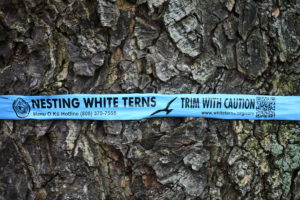
Stay tuned for upcoming details of the annual Manu o Kū festival starting May 1st with a grand finale on May 7th on the Iolani Palace lawn. Tours and activities will be posted throughout the week by Hawaii Audubon’s partner, the Conservation Council of Hawaii: conservehawaii.org/manuokufestival2022/
The Hawaii Audubon Society owns, monitors, and treasures an acre of land in Kahala’s Black Point neighborhood, a gift in 2007 from Houghton and Doreen Freeman, after ‘Ua’u kani (wedgies) were found nesting among the rocks and rubble of the vacant lot.
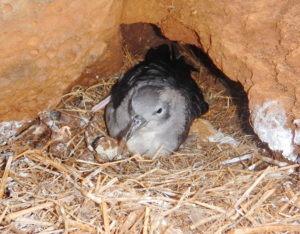
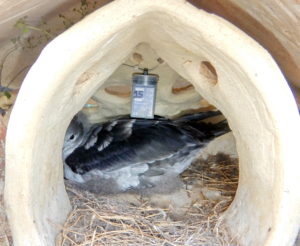
Ceramic nest made through HAS partner, Oikonos Ecosystem Knowledge.
Wedgies nest in self-dug burrows, rocky caves (left) or ceramic homes crafted by human helpers (below). The thermometer hanging from the ceiling records temperatures inside the artificial homes. The enclosures remain comfortably cool for parents and chick. © Susan Scott photos.
The nesting season runs April through November. With tender loving care offered by over 20 volunteers, the land plot, called, the Freeman Seabird Preserve, freemanseabirdpreserve.com/, recently had the highest wedgie count so far. In 2021, researchers counted 408 nests, meaning 816 parents attempted to raise chicks there. By mid-September, 276 fat, fluffy chicks had survived. (Some eggs don’t hatch, some chicks die naturally for unknown reasons, and roaming house cats and rats kill others.)
Volunteers pull weeds, plant native plants, construct wedgie housing and arrange for students to tour and work there.
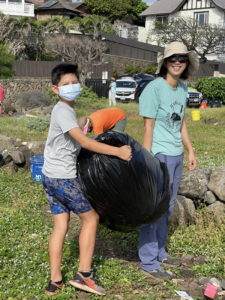
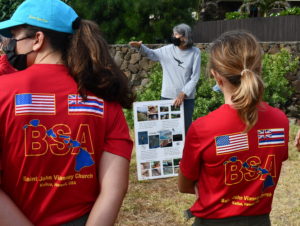
(Left) Audubon Board member, Dr. Yvonne Chan, and her son, Alex, help pull weeds at FSP. (Right) Audubon Board member, Wendy Johnson, explains wedgie facts to several Kailua Eagle Scouts (girls can now be Eagle Scouts) who recently helped plant, build, and weed. ©Susan Scott
You can join us in the above projects through the Audubon website, or just join Hawaii Audubon to support our efforts. The Hawaii Audubon Society is the only one of about 450 Audubon groups in the U.S. with its own scientific journal, the ‘Elepaio, hiaudubon.org/elepaio-journal and also the only one that publishes its own book, Hawaii’s Birds: hiaudubon.org/shop/
When our air and water temperatures rise a bit more, I’ll be getting back in the water for my daily swims. In the meantime, I’m enjoying land with the birds.
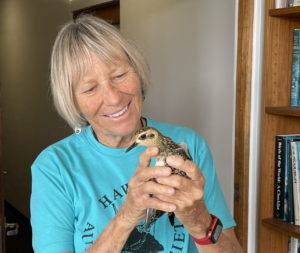
Kind workers at the King Street Goodwill store called the Manu o Kū hotline printed on the blue ribbons to help us get this injured Kolea to the Feather and Fur Animal Hospital. (HAS’s Executive Director, Susanne Spiessberger, took this picture of me with the injured bird at the Hawaii Audubon Society’s office.)